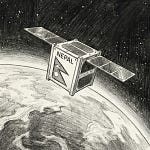Spot our new header & logo? Tell us what you think!
If you like this issue, share it with a friend who follows Nepal and hit Subscribe for your weekly dose of curated, can’t-miss updates.
Ten years after the great quake, candles were lit at Dharahara—and the ground promptly shook again with 30,000 striking teachers and a suddenly‑shaky MCC grant. Yet between new flyovers, booming EV sales, and snow‑leopard head‑counts, Nepal keeps finding ways to rise (or at least duck‑cover‑hold) with style. Ready for the week’s aftershocks and upshots? Let’s dive in!
Social & Cultural ⭐
Honouring a decade of resilience, Nepal marked Earthquake Memorial Day at the fully restored Dharahara complex in Sundhara, where Prime Minister Oli joined civil servants, survivors, and youth activists to light candles and observe a minute’s silence at 11:56 am—the exact moment the 7.8‑magnitude quake struck in 2015, Republica. Across the country, memorial events ranged from photo exhibitions in Gorkha and Bhaktapur to community‑run drills in Pokhara and Janakpur, reflecting a vibrant culture of remembrance and a commitment to build back stronger. Under the “Build Back Better” blueprint—championed by the National Reconstruction Authority, ADB and local NGOs—authorities have reconstructed nearly 90 % of damaged homes, retrofitted 7,500+ schools for seismic safety, and restored hundreds of shrines and heritage monuments, transforming tragedy into community assets, KTM Post.

Progress on the ground remains encouraging. Community masons trained under NRA schemes are now retrofitting homes in Lamjung and Kavre, municipal rapid‑response units have staged over 1,200 duck‑cover‑hold drills in public schools, and the rebuilt Dharahara park finally offers Kathmandu a rare, permanent evacuation hub, AFP. Yet preparedness cannot rest on good news alone. A fresh KTM post investigation warns that many of the Valley’s designated open spaces are disappearing, while only 40 % of municipalities have the engineers needed to enforce updated building codes. National Society for Earthquake Technology (NSET) president Amod Mani Dixit urges local leaders to pair every ribbon‑cutting with regular community drills, transparent construction monitoring, and legally protected gathering grounds—so hard‑won gains aren’t lost when the next tremor hits.
Politics & Governance 🪧

Education, already under strain from a three-week teachers’ strike, reached a tipping point when Minister Bidya Bhattarai resigned on 21 April—officially for “health reasons,” but insiders say she quit after her seven-point deal with unions stalled and Prime Minister Oli hardened his stance, according to Republica. Thousands of community-school teachers remain in Kathmandu demanding the stalled School Education Bill guarantee pay parity and job security; their boycott has shut public classrooms, postponed Grade 12 exams by ten days, and prompted the Supreme Court to order teachers back within three days, reports the KTM Post. Traffic snarls, frustrated parents, and postponed admissions underscore the impasse, while UML veteran Raghuji Pant has been rushed in as the new education minister and the Nepali Congress hints it could exit the coalition if Oli keeps “stonewalling” core demands—leaving Pant to turn street chants into classroom lessons, notes the same outlet.
Just across the border, militancy rattled South Asia when gunmen killed 26 tourists—including Nepali youth Sudip Neupane—in Kashmir’s Pahalgam resort on 23 April. Nepal swiftly condemned the “barbaric” attack; President Paudel, PM Oli, and Foreign Minister Deuba offered condolences, and Oli phoned India’s PM Modi to reaffirm joint resolve against terror, reports the KTM Post. The tragedy is a sobering reminder that instability in Kashmir can ripple through Nepal’s diaspora and tourism sectors, reviving calls for tighter regional security coordination as the spring trekking season peaks.
Economy & Development 💸
The abrupt decision by the Trump-era DOGE office to wind down the Millennium Challenge Corporation has jolted Kathmandu, but officials say the high-voltage transmission lines and East-West Highway upgrades will press on—even if Nepal must foot the entire Rs 92 billion bill. Internal discussions at the Finance Ministry point to reallocating next year’s budget and trimming lower-priority projects, while advisers lobby Washington to rethink the aid cut, note Republica and the KTM Post. With revenues sagging and only 28 percent of pledged grants arriving this fiscal year, the move underscores how quickly external finance can vanish—and why Nepal is scrambling for new funding tools.
To bridge the yawning Rs 21 trillion SDG funding gap by 2030, planners are tapping fresh ideas. A Rs 100 billion Alternative Development Finance Fund bill in Parliament would blend bonds, equity, and diaspora cash for big-ticket infrastructure, while a separate e-governance push aims to cut red tape and attract private investment, Republica reports. Meanwhile, import data tell a green story: nearly 21,000 electric vehicles—worth Rs 20 billion—have rolled across the border in nine months, and telecom giant Ncell just became Nepal’s first licensed cloud-services provider, positioning its Tier-III data centres for banks and government workloads, adds the KTM Post.
Concrete progress is visible on the ground: the Gwarko flyover, Nepal’s first, is 82 percent complete and slated to open by mid-June after daily penalties nudged the contractor into high gear, according to Republica. Up in Sankhuwasabha, ministers from Kathmandu and New Delhi jointly inaugurated Unit-2 of the 900 MW Arun III hydropower scheme, reaffirming cross-border energy ties, Republica reports. Tourism, too, is surging: nearly 700 trekkers entered Sagarmatha Park in a single day, even as a draft bill proposes stricter “7,000-metre prerequisite” rules for future Everest hopefuls, says the KTM Post and Republica. Together, the headlines flash a mixed but forward-leaning picture: foreign aid may wobble, yet domestic financing tools, green mobility, digital infrastructure and big builds keep Nepal’s development engine humming.
Diaspora & Globalization 🌏
Eid goodwill unlocked new beginnings as the UAE pardoned 166 incarcerated Nepalis and Qatar followed with 18 more—altogether 184 lives given a second chance, Republica. While embassies coordinate their return, Nepal is also luring skilled returnees: nine former hospitality pros with 147 collective years abroad have pooled savings and expertise to launch Chef’s Burger and a party venue in Kathmandu, proving that global experience can translate into home-grown jobs and quality service, Nepali Times.
NRNA turbulence meets fresh momentum. Founder Ram Pratap Thapa has boycotted a planned “Unity Convention,” warning it flouts the association’s statute, yet chapters keep moving forward—NRNA UK tapped neuroscientist Dr Kul Prasad Kandel as its new spokesperson, and NRNA Australia’s delegation told Prime Minister Oli they stand ready to ramp up investment if Nepal locks in a friendlier climate, Republica. Despite leadership squabbles, the diaspora’s energy—and capital—remain firmly focused on opportunities back home.
Did you know ❓
Nepal’s snow leopard population has been pegged at 397 individuals—nearly 10% of the global total—despite covering just 2% of the world’s suitable habitat, making Nepal home to the fourth largest population among the 12 range countries (THT). This national census, carried out by DNPWC and DoFSC between 2015–2024, used camera traps, genetic scat analysis, and the PAWS protocol to reveal an average density of 1.56 leopards per 100 km², underscoring the power of partnerships between government, WWF, NTNC, and local communities—while highlighting gaps in under-surveyed regions like Dhorpatan and Api-Nampa.
In a remarkable twist, a “Mountain Ghost” was filmed at just 146 m above sea level in Koshi Province—far below their usual 3,000–6,000 m alpine haunts—challenging assumptions about their adaptability, THT. With over 42% of critical habitat outside protected areas, Nepal’s new Rs 1.77 billion Snow Leopard Conservation Action Plan (2024–30) prioritizes habitat connectivity, community-based conflict mitigation, and transboundary cooperation, TRN. As experts convene in Kathmandu this week, Nepal’s pioneering assessment sends a global call: invest in science-driven strategies and grassroots stewardship to secure the “God of the Mountains” for generations to come.
Let’s connect
Enjoying this issue? 📩 Share it with a friend & let’s keep Nepalis worldwide in the loop! Got thoughts? Hit reply—we’re all ears! Or let us know what you think via our Feedback form or follow us on Facebook | LinkedIn
P.S. Got a story or issue you'd like us to cover next week? Drop us a reply — we're building this space together.
About Nepali Diaspora Digest:
The Nepali Diaspora Digest connects the global Nepali community with curated news, insights, and stories that matter most. Join us as we celebrate and explore the diverse voices and achievements of Nepalis worldwide.
Partner shout out
belayat.uk: helping Nepalis connect in the UK on jobs, housing, events and finding local Nepali owned businesses















